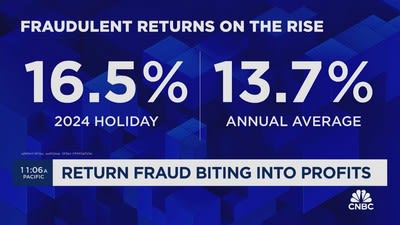
As retailers tried to win shoppers and boost sales in recent years, they made their online return policies more lenient than ever.
But those changes have come at a cost.
As more consumers shop online and send back more of those orders, retailers have moved to crack down on fraud. In some cases, shoppers can send back different items than the ones they bought, return stolen items or claim a purchase never got delivered when it really did.
Retailers estimate 13.7% of returns, or $101 billion worth, were fraudulent last year, according to a survey by Appriss Retail and the National Retail Federation. The share of returns expected to be fraudulent during the peak holiday season was even higher at 16.5%, or $24.5 billion worth, the survey found.
Those goods are still flowing back in, as many retailers extend return windows for purchases made in November and December through the end of January. As retailers field those returns, fraud has become their top concern, industry experts said.
“Fraud is No. 1, and it’s not even close to No. 2,” said Vijay Ramachandran, vice president of go-to-market enablement and experience at shipping and mailing firm Pitney Bowes.
Processing an online return is already a costly proposition: It averages 21% of an order’s value, according to a Pitney Bowes survey of 168 retailers. Half the respondent companies paid more than 21%.
The cost of processing a return is increasing not only due to higher shipping and processing costs, but also because of rising fraud, industry experts said. As those tactics spread, many companies have started to make it tougher to return items.
“In cases where fraud is on the rise, like this year, what we’ve seen in the data, retailers are forced to, at minimum, change their policies slightly to accommodate for that potential fraud and abuse,” according to Michael Osborne, CEO of Appriss Retail, which helps companies manage theft and fraud. “It does increase their costs and essentially erode their margin.”
Saks CEO Marc Metrick said at the NRF Big Show in mid-January that while the retailer has long received legitimate complaints from customers about missing items, fraudulent “merchandise not received” complaints to the company have more than doubled over the past several years.
That’s just one fraudulent return tactic.
Shipping back an empty box or a different item than was received, such as a box of bricks instead of a television, is the most common form of return fraud, according to Pitney Bowes’ Ramachandran. In other cases, fraudsters could return stolen goods. In another example, they could also dig through trash to find a receipt, then go into that store, find that product and take it to the return desk.
“There are examples of price arbitrage where someone will buy a product on sale or promotion, and then return it for full price in order to get the delta of that benefit back to them, basically stealing those extra dollars,” Osborne of Appriss Retail said.
“Credit laundering, too, where they’re taking things like gift cards or store credit and using that to buy a product, then returning it and putting that money back onto a different card, allowing them to take the money from potentially a stolen or fraudulently obtained gift card or credit,” he added.
Appriss Retail gave CNBC an example of one person who netted upward of $224,000 by fraudulently returning more than 1,000 items to 215 stores across multiple states, using a variety of return tactics.
Return abuse is more common
There’s also less egregious behavior, often considered return abuse rather than fraud. It includes “bracketing” or “wardrobing.”
“Bracketing” is where a shopper buys more than one size or color with the intent of returning whichever doesn’t work for them. While not fraud, it still puts a return expense on the retailer. “Wardrobing,” when shoppers buy an item, use it and then return it, is considered a bigger issue.
More than half, or 56%, of consumers confess to “wardrobing,” according to a survey from fraud prevention firm Forter. One in four consumers said they bought an item during the 2023 holiday season with the intent to return it after use.
Forter Head of Risk Doriel Abrahams said premeditated, intentional returns after use are especially problematic.
Just under half, or 47%, of those who planned to “wardrobe” during the holiday season were between the ages of 18 and 34, according to Forter. “Wardrobing” happens with lots of products, not just clothing.
“I have heard of people, every time they move an apartment, they buy tools, drills, whatever, put up the shelves and the things they need, and then just send it back,” Abrahams said.
How retailers are combating return fraud
Elevators inside an Ikea store in Doral, Miami.
Jeff Greenberg | Universal Images Group | Getty Images
Bad actors that commit return fraud are hurting honest shoppers as retailers make their policies stricter to prevent abuses, those who track the tactics said.
“It’s really putting a damper on your own experience, because right now, I look at it like the Plexiglas at the drugstore. We’re having to do a version of that on our website, we’re adding friction to the customer experience, to even the good actors” Saks’ Metrick said. “That’s a problem for us, and we’re going to have to fix it.”
Return fraud has caused several retailers to tighten policies for all consumers. Some even use artificial intelligence and other technology to personalize their return policies, which could vary for each individual.
“Certain retailers offer the ability for you to have different return windows based on your known history with that retailer, essentially equivalent to a loyalty program status level,” said Osborne. He said some companies such as Amazon have adopted that strategy, and “that’s where other retailers need to go.”
Amazon did not directly say whether it’s seeing more return fraud. Company spokesperson Kristina Pressentin said, “Amazon continues to make progress in identifying and stopping fraud before it happens” and that it “uses advanced machine learning models to proactively detect and prevent fraud, as well as employs specialized teams dedicated to detecting, investigating and stopping fraud.”
Companies have tried to keep consumers happy in an increasingly competitive retail environment by offering lenient return policies. Nearly three-fourths, or 73%, of shoppers choose a retailer based on the return experience and 58% want a smooth, no-questions-asked return experience across channels, according to a survey by Appriss Retail and Incisiv.
But companies have to try to strike a delicate balance between appeasing those customers and trying to lower return costs and incidences of fraud and abuse.
“It’s not a coincidence, that one bright day, eight months ago, almost every company started to charge for shipping returns, or started to have more restrictive return [policies],” Forter’s Abrahams said. “The money talks. At the end of the day, if you’re seeing that you’re starting to pay too much for restocking, or validating the items that are being returned, or shipping costs for returns, then you’re going to have to hold those costs to your clients.”
Don’t miss these stories from CNBC PRO:








